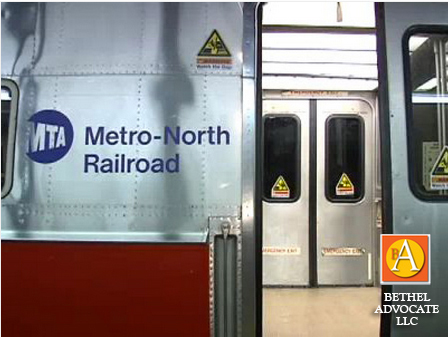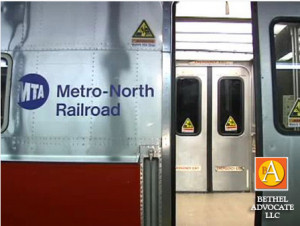
Report by Paula Antolini
February 14, 2017 1:10PM EDT
Murphy, Blumenthal, Esty Call on Metro-North to Provide Plan for Upgrades & Better Service in Wake of Low Ridership
Members: “Better service will increase ridership, which will increase investment, creating a virtuous cycle benefitting commuters of all stripes.”
WASHINGTON – In response to a recent report that ridership on Connecticut’s three Metro-North branch lines have declined, U.S. Senator Chris Murphy (D-Conn.), U.S. Senator Richard Blumenthal (D-Conn.), and U.S. Representative Elizabeth Esty (CT-5) sent a letter asking MTA-Metro-North Railroad to provide a detailed plan for improving service and increasing ridership on the Waterbury, Danbury, and New Canaan Branch lines. In a letter to MTA-Metro-North Railroad President Joseph Giulietti, the members of Congress cited clear examples of when service improvements along the branch lines have led to increased ridership, and when lapses in service have led to decreased ridership. They emphasized the importance of reliable train service to Connecticut residents and argued that upgraded train service along the three branch lines will increase ridership.
“Recent reporting and MTA ridership data suggest that consistent lapses in services on the Waterbury, Danbury, and New Canaan Branch Lines have led to a decline in ridership. With that in mind, we write today to convey our deep concern about this trend, particularly because its cause—poor service,” wrote the members of Congress. “Riders are frustrated, and they want better service. Better service will increase ridership, which will increase investment, creating a virtuous cycle benefitting commuters of all stripes. Therefore, we respectfully ask you to provide us and branch line riders with your plan for improving service and increasing ridership on the branch lines in the near- and long-term.”
The full text of the letter is available online and below:
Mr. Joseph Giulietti
President
MTA-Metro-North Railroad
420 Lexington Avenue
New York, NY 10017-3739
Dear Mr. Giulietti,
As we communicated to you in an August 26, 2016 letter, we have seen firsthand what improvements to Metro-North Branch Lines mean for Connecticut residents. Working with local advocates and stakeholders, including the MTA, we have fought hard to improve the lines that, put simply, make people’s lives more safe and convenient. In particular, we are pleased with the progress of the Waterbury Branch Line’s signalization project, which will include passing sidings to allow two-way traffic on the line for the first time.
When we last wrote, the month-over-month ridership on branch lines was increasing, underscoring the increasing utility of the line as well as the increased awareness surrounding its long-overdue improvements. However, recent reporting and MTA ridership data suggest that consistent lapses in services on the Waterbury, Danbury, and New Canaan Branch Lines have led to a decline in ridership. Despite the record-setting ridership on the New Haven Line, all three branch lines experienced declines in ridership. With that in mind, we write today to convey our deep concern about this trend, particularly because its cause—poor service—may be mistaken for a lack of demand. Nothing could be farther from the truth. Our constituents continually clamor for more frequent and reliable service on these lines. For some, the branch lines are the only way for thousands of my constituents to get between their jobs and families.
In fact, a clear line can be drawn between service improvements and increases in ridership. As the Waterbury Republican-American recently recounted, in 2008, when the Waterbury Branch Line added an early 6 a.m. train, ridership on the line jumped 33.8 percent, then 10.5 percent and 15.6 percent in subsequent years. Ridership on the Danbury Branch Line has been increasing because of better service and infrastructure. Further, the most modern of the branch lines—the New Canaan Line, which is the only electrified branch—also has the highest ridership. However, a clear line can also be drawn between declines in quality service and ridership. For instance, it comes as no surprise that ridership slipped on the Waterbury Branch Line in 2016, when the on-time rate dropped to 75 percent in the summer and long-delays and poor communication to commuters plagued the line. Nor does it come as a surprise that ridership decreased in 2016 when riders were directed to bus service over 100 times.
Our message is clear: Riders are frustrated, and they want better service. Better service will increase ridership, which will increase investment, creating a virtuous cycle benefitting commuters of all stripes. Conversely, devolving service quality and reliability may cause people to mistakenly question the soundness of investments in the lines, jeopardizing future funding for improvements. Therefore, we respectfully ask you to provide us and branch line riders with your plan for improving service and increasing ridership on the branch lines in the near- and long-term.
We look forward to your prompt response and to partnering with you to improve commutes for the customers you serve.
Sincerely,
CHRISTOPHER S. MURPHY
United States Senate
RICHARD BLUMENTHAL
United States Senate
ELIZABETH H. ESTY
Member of Congress

